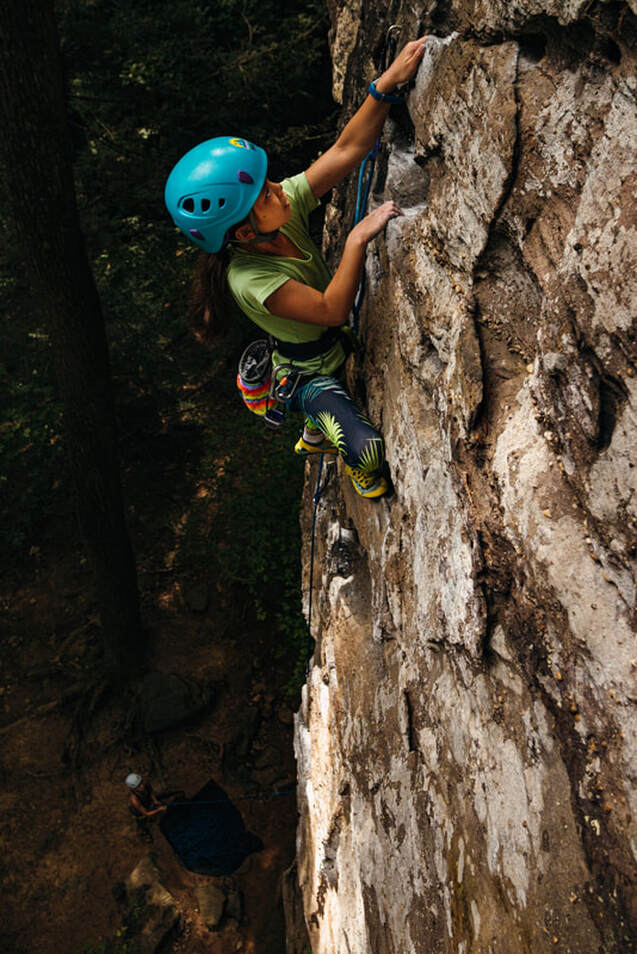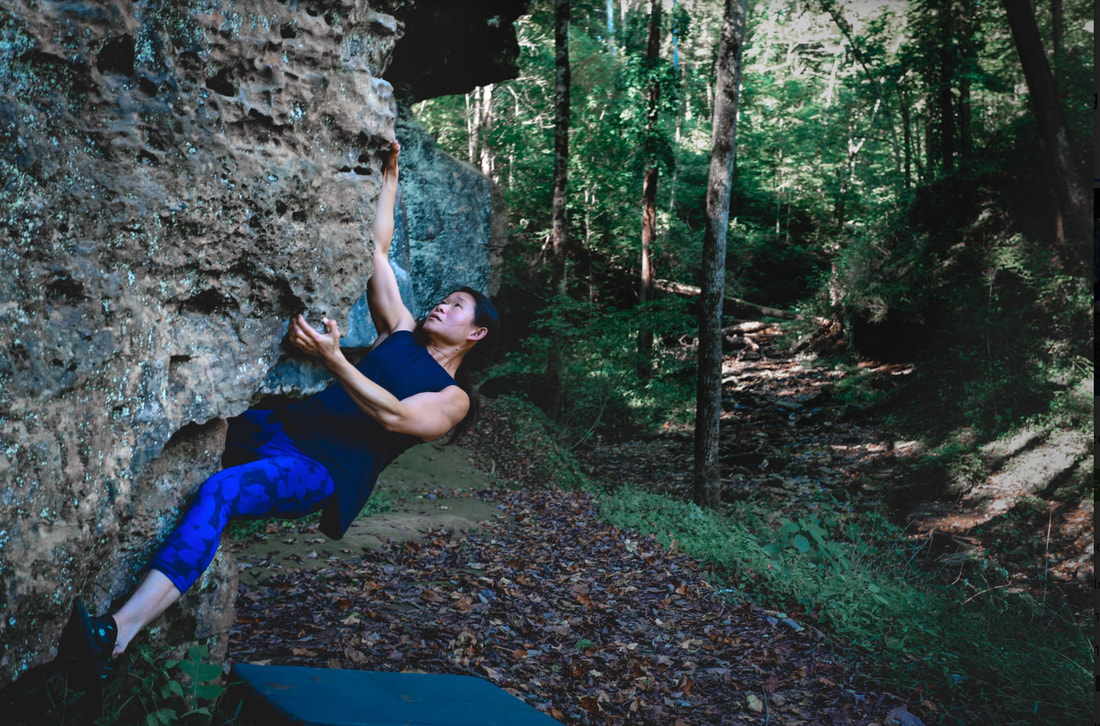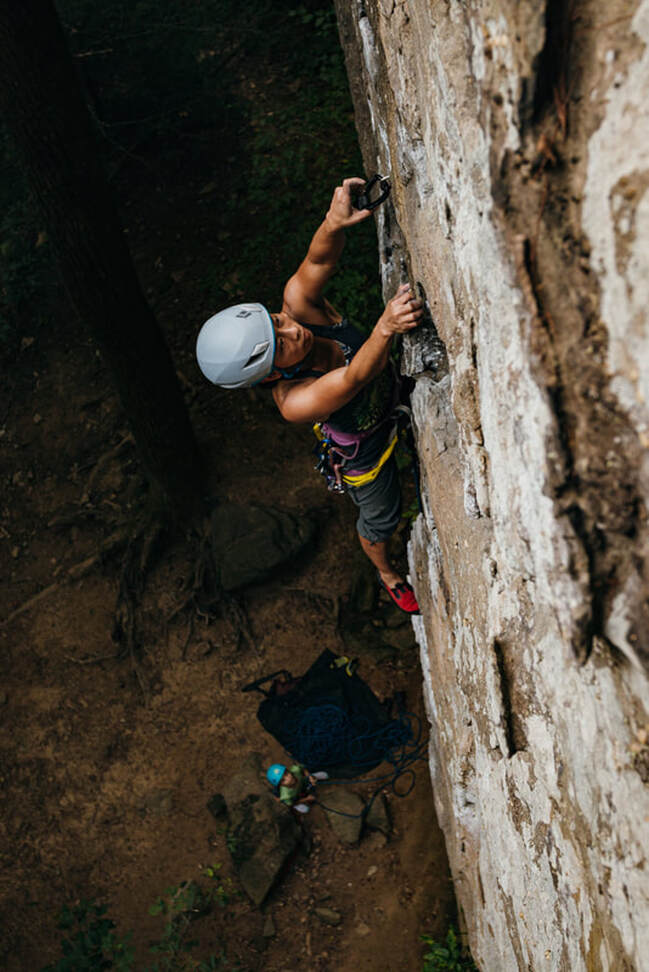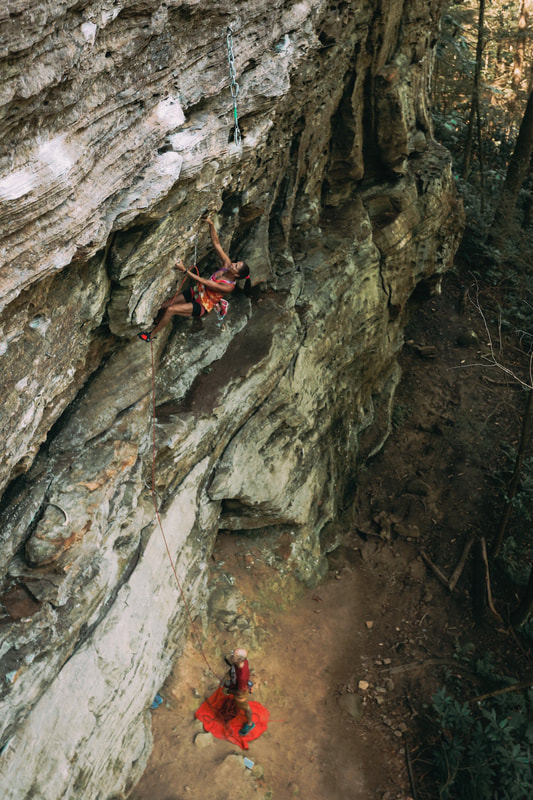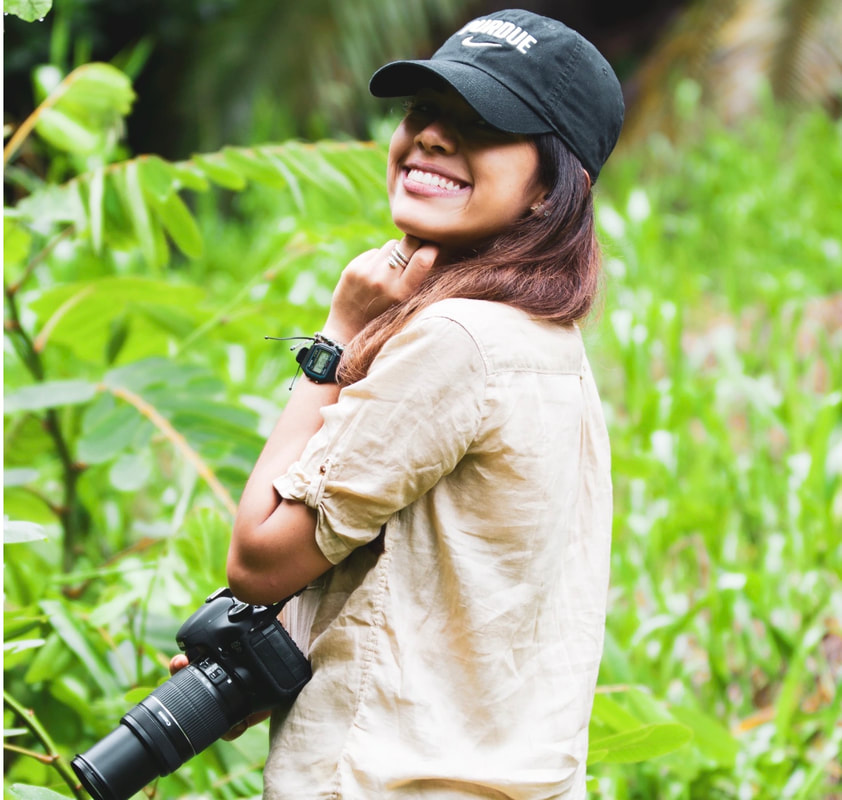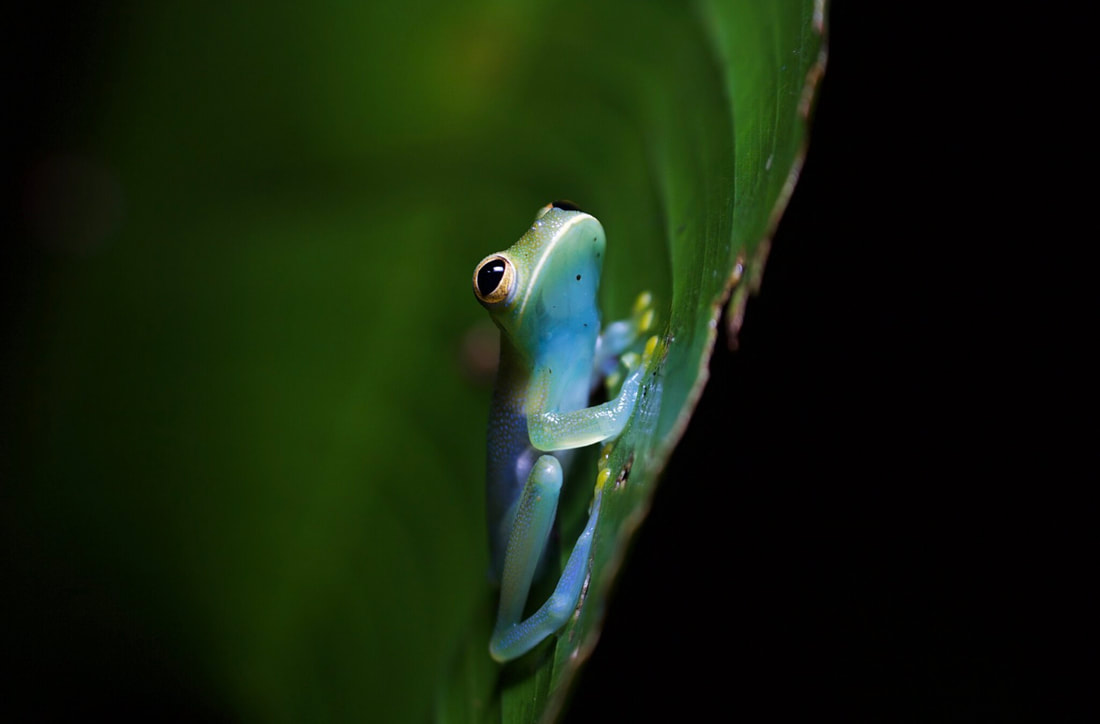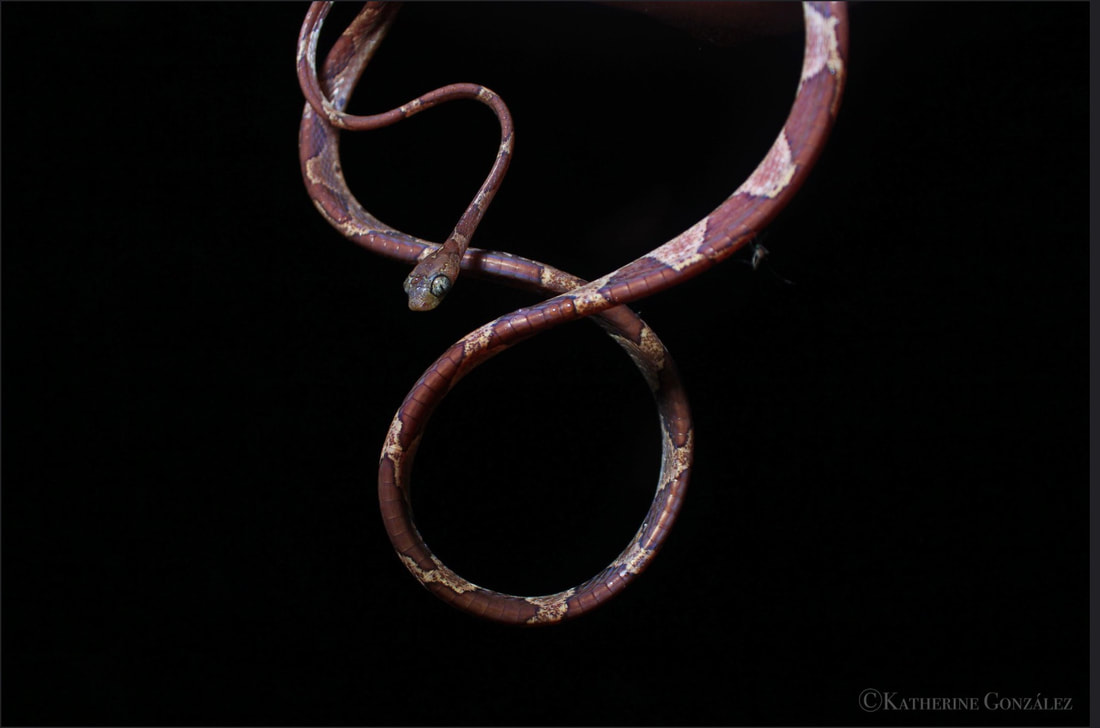You are from Costa Rica and working on your PhD in Ecology and Evolutionary Biology at Purdue University in Indiana and you are a climber and photographer! Wow! Since we are a climbing magazine, let's begin with the rock climbing side of things. Tell us about your rock climbing genesis - how and when you started to rock climb and how it has evolved [I had to work evolution in there somehow :-) ]
I was introduced to the sport in 2020, but it wasn’t until February of 2021 that I started climbing. As an evolutionary biologist, one of my favorite concepts in evolution is called phenotypic plasticity: the ability to physically express genetic traits that allow an organism to survive depending on the environmental conditions. Thus, one individual can perform very differently depending on the environment in which they grow. I like to use this metaphor with my climbing journey.
I was introduced to the sport by a former partner, but the relationship was toxic and emotionally abusive. When I left this relationship, my environment changed. I was not longer neglected or belittled by this person and, in fact, found supportive folks at the gym. I built a healthy relationship with climbing. I would climb a 5.6 maybe 3 times in a row and then I would try a 5.7. At some point in my training session, I would try something harder…”just to see how it feels." The best part? No one was watching me, judging me, or making fun of me. I would fall and within seconds I would be back on the wall. I went from 5.8 to 5.10 within just a few weeks.
I also bought two books: “Rock climbing: Mastering Basic Skills” and “How to Rappel” by Craig Luebben and learned as much as I could from them. I read a chapter each night and started to climb at my local gym two to three times per week. Then, I transitioned to outdoor climbing when I took a lead climbing class and felt comfortable enough with my abilities to join other women outdoors. I still have tons to learn about climbing and really want to improve my technical skills, but the community is what keeps me here!
I was introduced to the sport in 2020, but it wasn’t until February of 2021 that I started climbing. As an evolutionary biologist, one of my favorite concepts in evolution is called phenotypic plasticity: the ability to physically express genetic traits that allow an organism to survive depending on the environmental conditions. Thus, one individual can perform very differently depending on the environment in which they grow. I like to use this metaphor with my climbing journey.
I was introduced to the sport by a former partner, but the relationship was toxic and emotionally abusive. When I left this relationship, my environment changed. I was not longer neglected or belittled by this person and, in fact, found supportive folks at the gym. I built a healthy relationship with climbing. I would climb a 5.6 maybe 3 times in a row and then I would try a 5.7. At some point in my training session, I would try something harder…”just to see how it feels." The best part? No one was watching me, judging me, or making fun of me. I would fall and within seconds I would be back on the wall. I went from 5.8 to 5.10 within just a few weeks.
I also bought two books: “Rock climbing: Mastering Basic Skills” and “How to Rappel” by Craig Luebben and learned as much as I could from them. I read a chapter each night and started to climb at my local gym two to three times per week. Then, I transitioned to outdoor climbing when I took a lead climbing class and felt comfortable enough with my abilities to join other women outdoors. I still have tons to learn about climbing and really want to improve my technical skills, but the community is what keeps me here!
|
In one of your blogs you talk about how you felt excluded and left out as a climber - the expensive gear, the specialized language (beta, crux, mono, etc.), the competitive nature of it. It almost drove you to quit - several times. But, something in you wanted to continue. Can you share a bit about that experience?
It is not a secret that climbing is a white male dominated sport and to me it was pretty evident since the beginning, especially in the Midwest. The gatekeeping starts with the basics: gear, climbing gyms fees, trips, and of course the jargon, but what got me the most was the competitive nature of it. As much as I ask other climbers about the sport or gear, the answers are always ambiguous and short. I have also found that many folks place more value on the grades you climb or the gear brands you wear and don’t value the connections. This can really get to you, especially if you come from marginalized communities. Fortunately, I found other women with similar experiences, and we started to grow together as climbers. In the end most of us want to feel we belong and that we have a healthy support system in our climbing community, which in my case has been fundamental in my journey in the United States. From leaving a toxic relationship and feeling completely alone in this country to finding myself climbing with amazing folks and enjoying nature definitively brought my joy back! |
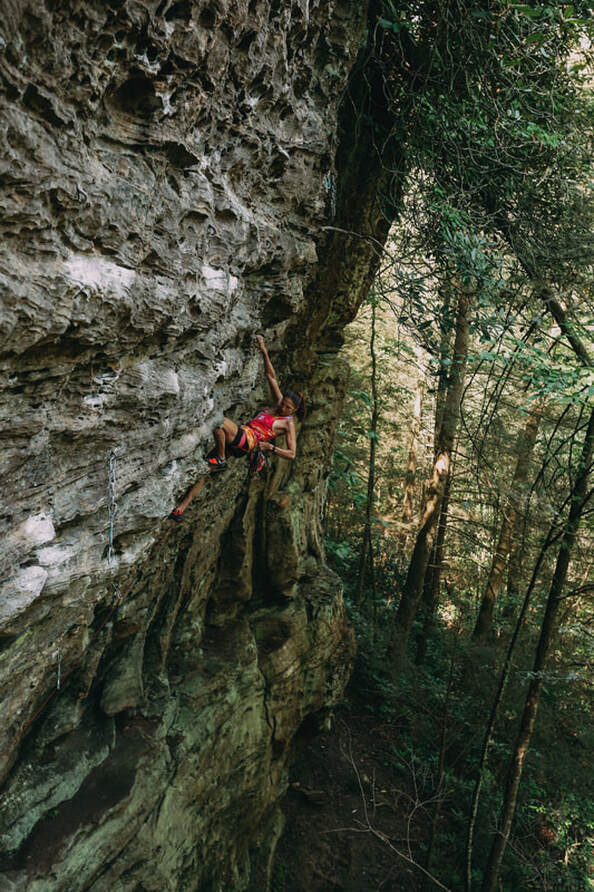
Margarita Martinez
(IG: @drypointe)
is on “Drugs are Bad, Mkay?”, Red River Gorge, Kentucky. Margarita is part of the "Climbing with Immigrants" photo series. Kathrine says: "Margarita, who is from Puerto Rico was my first climber to photograph and from her I learned it is okay to assimilate some part of the American culture while keeping your home country cultural identity." (Photo Credit: Katherine González)
|
What would you say to a newer climber or someone who might feel intimidated by the "culture of climbing?"
That those feelings are valid and spot-on.
I truly believe that anyone belongs to climbing because climbing is about yourself and how you connect with your own body. Climbing is intimidating because it is not only a sport, it is also dangerous and competitive. When you start climbing your body is going to respond to it with fear, anxiety, adrenaline, and soreness. It is important to understand this, as your body is trying to keep you alive.
It's also important that when you make one small progression to think about it and repeat it. That small progression will replicate session after session and then, your body will respond back by getting stronger and calmer. That inner strength of finding joy in something like climbing is the best thing about the sport.
The other component to climbing is the people. Who are the people you want to share your growth with? Are the people who support you the ones you want to climb with? Do they make you smile even when your climbing wasn’t the best? People who support you and make you smile are your community. Once you know who you are as a climber find your people and what you want from the sport, then everything else will follow.
That those feelings are valid and spot-on.
I truly believe that anyone belongs to climbing because climbing is about yourself and how you connect with your own body. Climbing is intimidating because it is not only a sport, it is also dangerous and competitive. When you start climbing your body is going to respond to it with fear, anxiety, adrenaline, and soreness. It is important to understand this, as your body is trying to keep you alive.
It's also important that when you make one small progression to think about it and repeat it. That small progression will replicate session after session and then, your body will respond back by getting stronger and calmer. That inner strength of finding joy in something like climbing is the best thing about the sport.
The other component to climbing is the people. Who are the people you want to share your growth with? Are the people who support you the ones you want to climb with? Do they make you smile even when your climbing wasn’t the best? People who support you and make you smile are your community. Once you know who you are as a climber find your people and what you want from the sport, then everything else will follow.
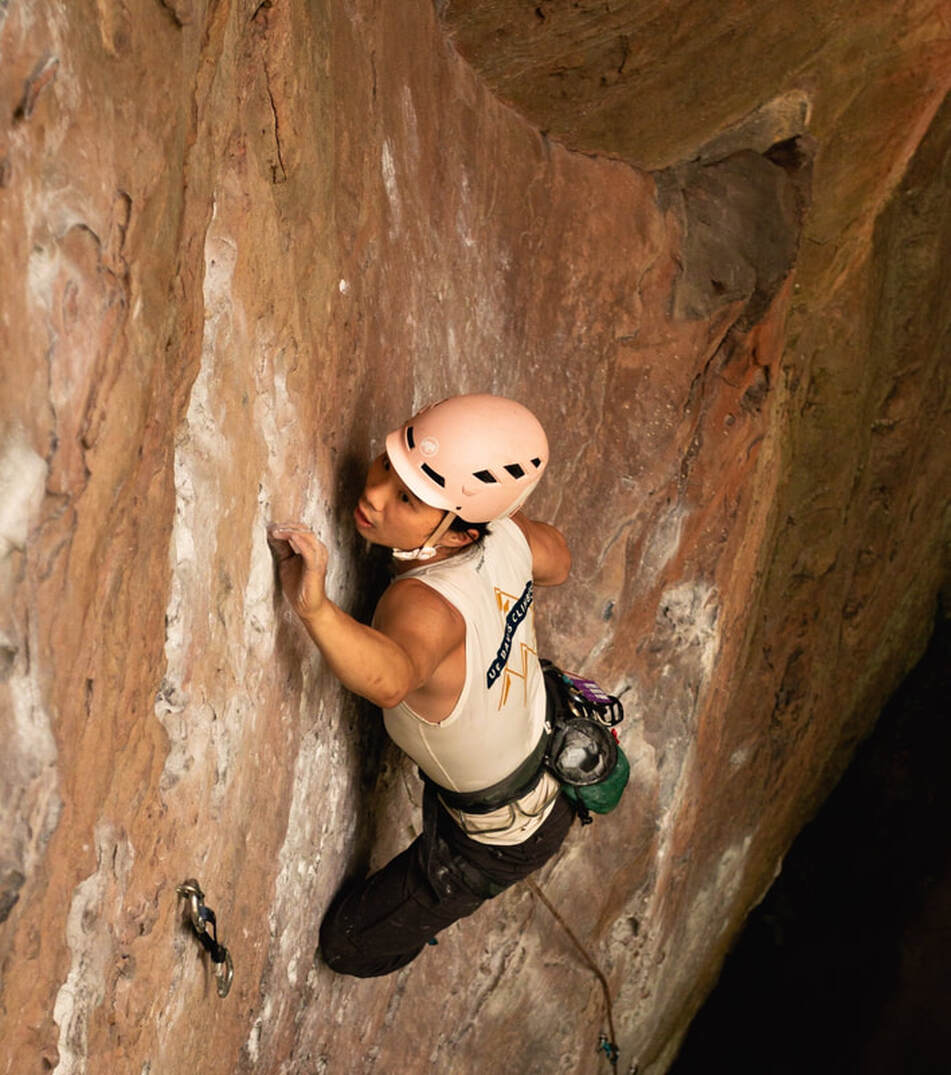
Andy Muan (he/they) (IG: @andyshootspictures) is on the climb “To Defy the Laws of Tradition” at the Red River Gorge, Kentucky. Andy is part of the "Climbing with Immigrants" photo series. They migrated from Taiwan and Katherine describes Andy as "unapologetically himself." (Photo Credit: Katherine González)
You are also a photographer who loves taking photos of reptiles and amphibians - the types of animals you are studying about in your degree - but you also take photos of rock climbing. You have a special photography project called "Climbing with Immigrants." Tell us more about that project - what prompted you to start it and what message you hope to convey through it.
When I first tried climbing outdoors, I had a hard time digesting everything about it. I feared climbing because I knew very little about it. I was also still assimilating the transition from my home country to the US. I felt alienated at the crag and didn’t climb for the whole weekend. The only familiar thing that I had with me was my camera, so I snapped pictures of my friend Andy. It felt great, but when I came back home I started wondering if there were more people like me out there…immigrants navigating similar experiences and feeling they didn’t belong in the climbing community.
I wanted to my make my personal climbing experience more meaningful and built real connections with people. This is how “Climbing with Immigrants” was born.
The concept of the project is very simple. Two immigrants climb outside for a day and I take a picture of them climbing. But what happens after is the most amazing part of the project. We get to know each other’s migration story. We talk about their families, what they love the most about their home country and what role climbing has in their life journey in the U.S. When they read their story through the eyes of another immigrant, they feel seen, validated, supported, and empowered. They feel even more empowered when they see their picture climbing strong and determined!
When I first tried climbing outdoors, I had a hard time digesting everything about it. I feared climbing because I knew very little about it. I was also still assimilating the transition from my home country to the US. I felt alienated at the crag and didn’t climb for the whole weekend. The only familiar thing that I had with me was my camera, so I snapped pictures of my friend Andy. It felt great, but when I came back home I started wondering if there were more people like me out there…immigrants navigating similar experiences and feeling they didn’t belong in the climbing community.
I wanted to my make my personal climbing experience more meaningful and built real connections with people. This is how “Climbing with Immigrants” was born.
The concept of the project is very simple. Two immigrants climb outside for a day and I take a picture of them climbing. But what happens after is the most amazing part of the project. We get to know each other’s migration story. We talk about their families, what they love the most about their home country and what role climbing has in their life journey in the U.S. When they read their story through the eyes of another immigrant, they feel seen, validated, supported, and empowered. They feel even more empowered when they see their picture climbing strong and determined!
|
I think this sport has the greatest potential to empower marginalized communities like immigrants and in my personal experience climbing has been instrumental in my healing journey and assimilation of a new environment. When these climbers tell their stories and see a picture of themselves climbing it turns into a celebration of their life journey as immigrants that brought us all together at the crag.
Why have you selected rock climbing as the medium to tell these immigrant stories?
I think the first reason is that climbing is an excellent metaphor of the immigrant experience. Climbing a wall is an act of strength and braveness. Somehow it feels like immigrants are always breaking barriers in terms of language, cultural assimilation, and alienation, taking the step to the unknown and pushing higher. Just like climbing a wall. The second reason perhaps resonates more with my personal experience. When I started calling myself an immigrant around friends and family, many of them turned around and said: "Don’t call yourself that. That’s terrible!" When I google the word “immigrant” all I found were people of color looking sad, scared, and hopeless. It was jarring to me how something I considered so beautiful - thanks to my career as a biologist - could be perceived so negatively and so poorly represented in the media. I decided to do something about it and make my climbing experience as an immigrant in the U.S. more meaningful. I wanted to see immigrants who also look determined, brave, and strong. I think climbing is an excellent way to capture that immigrant experience. |
Can you share some photos and stories of some of the immigrants you have photographed?
So far, each of the stories have taught me valuable lessons and surprisingly, all these stories collectively tell one big story: the migration experience.
For instance, Margarita who is from Puerto Rico was my first climber to photograph and from her I learned it is okay to assimilate some part of the American culture while keeping your home country cultural identity. Margarita is also an active member of the climbing community at the Red River Gorge and it truly inspired me to always give back to the community I share space with.
Andy, who migrated from Taiwan, is unapologetically him, which is something I still struggle with, especially in predominantly white spaces where I tone down and try to make myself fit in.
Irena from Hong Kong was the hardest story to write because…well, how can you put in less than 2000 words the life of a person who has been through that much? Her resilience and braveness in the mist of the pandemic while battling depression really hit me because her story captures the experience of isolation that many immigrants go through.
Then, I climbed with Karla who is from the Philippines. I deeply admire Karla for taking such a huge role in the climbing community at the Muir Valley, while also raising the most amazing kid, Lucy.
Yiting, who is from Singapore, is a tremendous scientist and mother of two kids who reminds me to always be bold and grateful for the many opportunities this country has offered to people like us without losing our cultural identity.
So far, each of the stories have taught me valuable lessons and surprisingly, all these stories collectively tell one big story: the migration experience.
For instance, Margarita who is from Puerto Rico was my first climber to photograph and from her I learned it is okay to assimilate some part of the American culture while keeping your home country cultural identity. Margarita is also an active member of the climbing community at the Red River Gorge and it truly inspired me to always give back to the community I share space with.
Andy, who migrated from Taiwan, is unapologetically him, which is something I still struggle with, especially in predominantly white spaces where I tone down and try to make myself fit in.
Irena from Hong Kong was the hardest story to write because…well, how can you put in less than 2000 words the life of a person who has been through that much? Her resilience and braveness in the mist of the pandemic while battling depression really hit me because her story captures the experience of isolation that many immigrants go through.
Then, I climbed with Karla who is from the Philippines. I deeply admire Karla for taking such a huge role in the climbing community at the Muir Valley, while also raising the most amazing kid, Lucy.
Yiting, who is from Singapore, is a tremendous scientist and mother of two kids who reminds me to always be bold and grateful for the many opportunities this country has offered to people like us without losing our cultural identity.
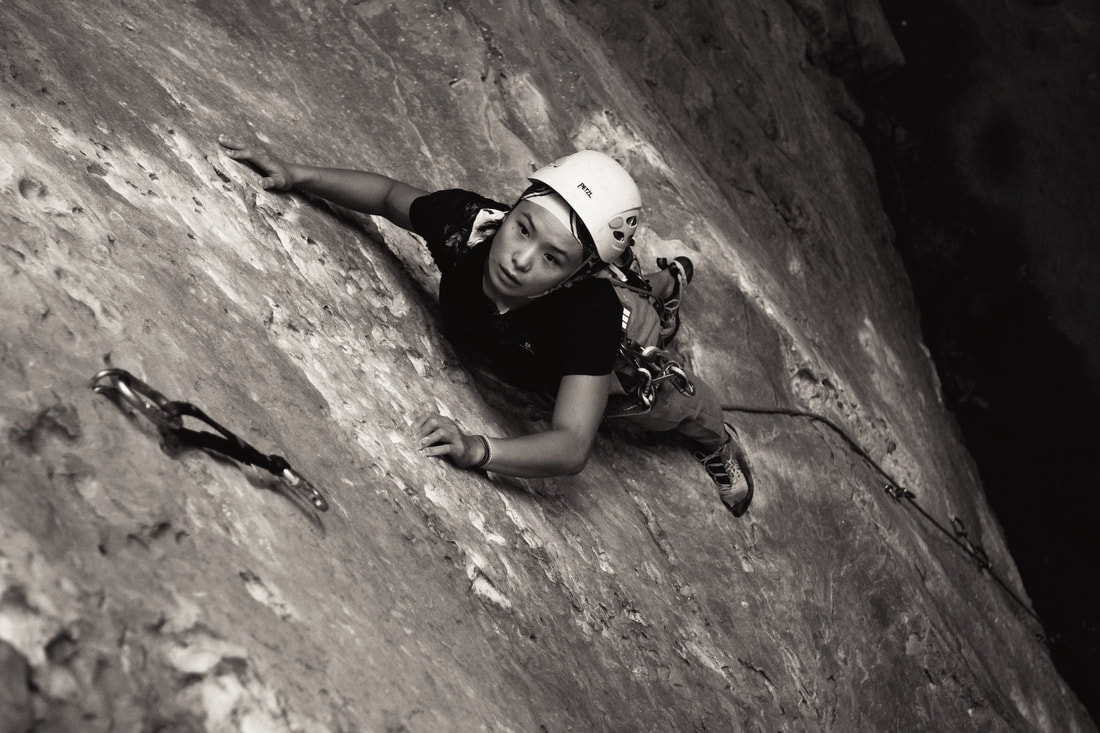
Irena Wong (she/they) (IG: @irena_wsy) is on the climb “To Defy the Laws of Tradition” at the Red River Gorge, Kentucky. Katherine says of Irena's "Climbing with Immigrants" photo story: "Irena from Hong Kong and was the hardest story to write because…well, how can you put in less than 2000 words the life of a person who has been through that much?" (Photo Credit: Katherine González)
Are these immigrants people you know in your community? How are you connecting with them?
I have met some of these climbers here in Purdue University while others I met through social media and my climbing gym. Facebook groups have been my best source of communication and all of these people have become part of my climbing community! All of these climbers are Common Climbers - people like you or me who work hard Monday through Friday and occasionally take time to climb outside! But perhaps the difference here is that these climbers navigate spaces from a different perspective, the immigrant perspective.
I have met some of these climbers here in Purdue University while others I met through social media and my climbing gym. Facebook groups have been my best source of communication and all of these people have become part of my climbing community! All of these climbers are Common Climbers - people like you or me who work hard Monday through Friday and occasionally take time to climb outside! But perhaps the difference here is that these climbers navigate spaces from a different perspective, the immigrant perspective.
Indiana isn't well known for climbing. Do you have a favorite local crag that you go to? Where do you go to climb?
Unfortunately, Indiana does not have many places to climb so I go the Red River Gorge, which I consider my home crag. But I have also been exploring the Muscatatuck in Southern Indiana and I would say it has a lot of potential for some weekend bouldering sessions with friends. I have also climbed in my home country, and it was an interesting experience, ticos are so loud at the crags!
Unfortunately, Indiana does not have many places to climb so I go the Red River Gorge, which I consider my home crag. But I have also been exploring the Muscatatuck in Southern Indiana and I would say it has a lot of potential for some weekend bouldering sessions with friends. I have also climbed in my home country, and it was an interesting experience, ticos are so loud at the crags!
You originally hail from Costa Rica, which has some of the greatest biodiversity in the world. Where do you envision yourself after you get your PhD?
Costa Rica is my dream place: it has mountains, pristine rivers, amazing wildlife, fresh fruits, nice food and beer, the most incredible sunsets, and the beach…well, I mean the place is just stunning.
Paradoxically, biologists struggle a lot to get a job and pay the bills. Often, people obtain a second degree or run small business to survive, so most PhD students stay in the U.S. after they graduate to pursue teaching positions at universities. I struggle a lot with the idea of limiting myself to doing one thing in my life, so I have been exploring the idea of doing science communication and storytelling either here in the United States or Latinamerica. I am really interested in bringing scientists and the public together to better understand and protect nature. There is still a lot to be done as scientists to better translate our science to the public and make better decisions as a whole society, especially with marginalized communities and threatened ecosystems.
Costa Rica is my dream place: it has mountains, pristine rivers, amazing wildlife, fresh fruits, nice food and beer, the most incredible sunsets, and the beach…well, I mean the place is just stunning.
Paradoxically, biologists struggle a lot to get a job and pay the bills. Often, people obtain a second degree or run small business to survive, so most PhD students stay in the U.S. after they graduate to pursue teaching positions at universities. I struggle a lot with the idea of limiting myself to doing one thing in my life, so I have been exploring the idea of doing science communication and storytelling either here in the United States or Latinamerica. I am really interested in bringing scientists and the public together to better understand and protect nature. There is still a lot to be done as scientists to better translate our science to the public and make better decisions as a whole society, especially with marginalized communities and threatened ecosystems.
|
How does rock climbing fit into your current life and where do you see it fitting into your future?
I always say that climbing came to my life in times when I desperately need to be reminded of who I am. Academia is brutal when it comes to acceptance and validation based on your ideas and it is constant work with respect to how to deal with rejection. Instead, climbing grounds me. It allows me to feel empowered in my own body and mind and it is giving me the family that I don’t have here in the U.S. I hope climbing keeps giving me that safe space where I can be creative with my photography and writing and perhaps take this experience to Central America where I know climbing could be instrumental to empower women and children from marginalized communities. I am also planning to get into tree climbing because well..I can used it as an excuse to get frogs and cool views in the jungle, right? Your research is on the mating communications of frogs. Are there any surprises you have encountered in your research?
Yes! My lab studies acoustic communication in frogs to understand how mating acoustic signals can be exploited by eavesdropping on enemies like bats or flies! The crazy part is that some of these eavesdroppers are tiny flies and if we start thinking and understating how they achieve this with such small antennae we could use this auditory system as a model for our own technology! |
How did you end up in a biological research career? Did you have parents, a teacher, or a mentor that encouraged you? Was there something that inspired you?
I call it my best life accident! I am a first-generation grad student and the only scientist in the family. I got into science because ever since I was little I always wanted to be in nature and protect it. In my college application I tried med-vet first to help animals, but my second career option was biology and that’s what I got! I am always inspired by the belief that every organism and element in nature plays a role in our planet and that we must do everything we can to protect it.
I call it my best life accident! I am a first-generation grad student and the only scientist in the family. I got into science because ever since I was little I always wanted to be in nature and protect it. In my college application I tried med-vet first to help animals, but my second career option was biology and that’s what I got! I am always inspired by the belief that every organism and element in nature plays a role in our planet and that we must do everything we can to protect it.
Any last words?
Stories like the ones I am telling with my project are around us - they could be the people who you climb with. If you know someone who is an immigrant in your climbing community, offer your support and space to talk and share a coffee. The journey as an immigrant to the U.S. is hard, but sharing a smile, a hug, and a catch is the best gift we can have!
Stories like the ones I am telling with my project are around us - they could be the people who you climb with. If you know someone who is an immigrant in your climbing community, offer your support and space to talk and share a coffee. The journey as an immigrant to the U.S. is hard, but sharing a smile, a hug, and a catch is the best gift we can have!

